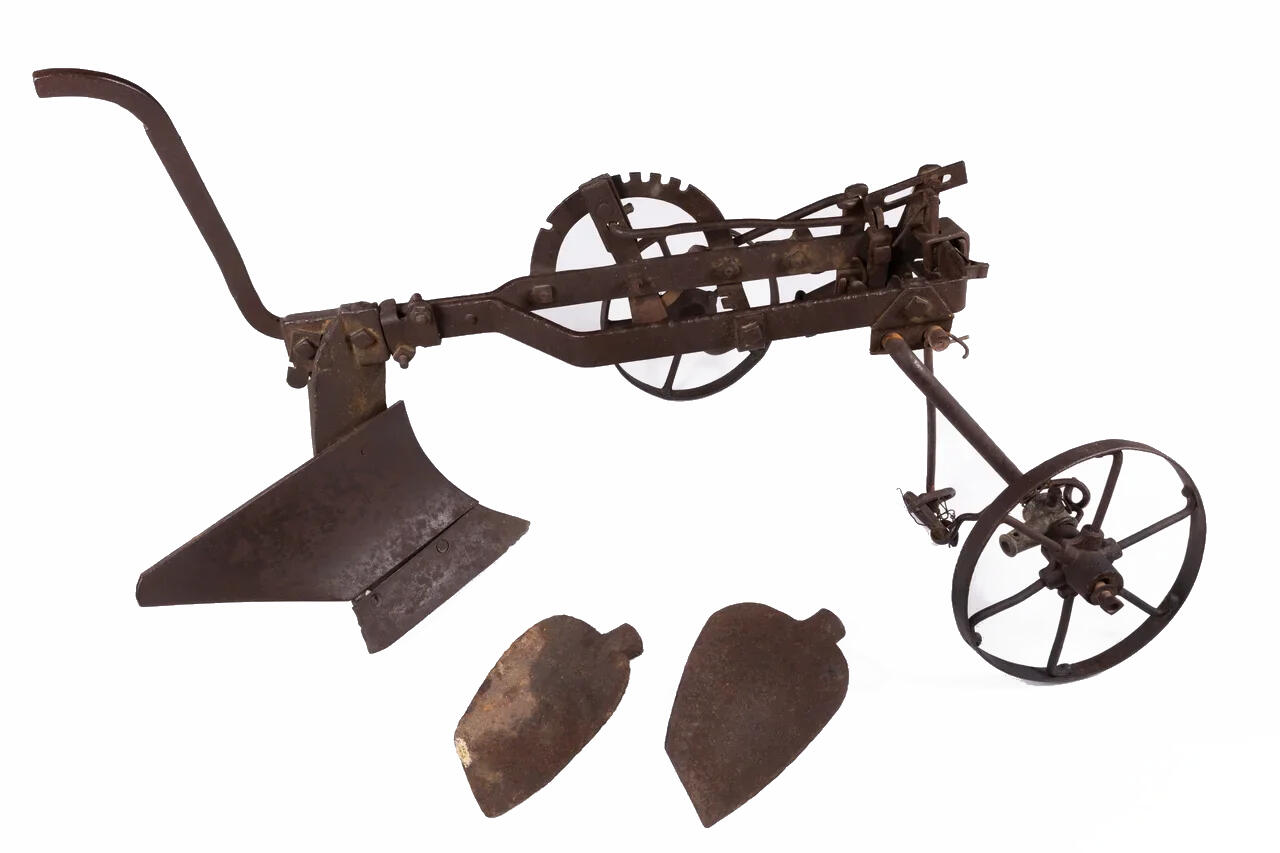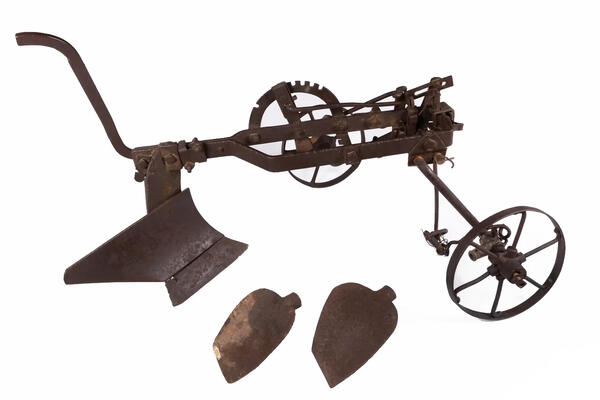The plow is a tool to plow dense soil or till poorly developed lands (virgin lands). First, the plows were pulled by the people themselves, then by oxen, and even later on by horses and mules. Today, in most industrialized countries, the plow is pulled by a tractor. The main job of the plow is to turn over the top layer of earth. Plowing cuts down on weeds, makes the soil softer, looser, and more unresisting, and makes planting easier. Most often, plows were made of wood and metal; the museum’s collection has a metal plow on display made in the 20th century.
The very first plows appeared in the third millennium B.C., and had a very simple design: they took the form of a frame (hitch) holding a vertically fixed sharpened piece of wood (the plowshare), which turned over the top layer of soil. Previously, both the plowshare and hitch were made from one piece of wood, as evidenced, for example, by the image of a plow on a Syracuse bronze coin. The earliest forms of this agricultural tool can also be recognized on Babylonian and ancient Egyptian images, rock face carvings in northern Italy and southern Sweden (dating back to the 2nd millennium B.C.), and by the remains of ancient plows found in the peat bogs in Poland.
Steel plows have been around since the industrial revolution. They were lighter and stronger than their iron and wooden counterparts. The first steel plow was invented by the American blacksmith John Deere in the 1830s. By this time, the hitch attached to the animal harness had been adjusted so that the wheel at the front of the plow rolled on the ground. The first steel plows were driven a man following on foot: he followed the plow, holding onto both handles, and regulated the direction and depth of the furrow. Later, plows appeared where the operator sat on a special seat on the wheels. Also, these plows had several tilling components.
One horse can usually pull the plow only along one furrow in clean, soft soil. Heavier soil required two horses, one for the furrow and the other on the untilled land. For plows that make two or more furrows, one or more horses must walk on free, untilled land, but even this is difficult for animals to accomplish. Usually, these horses were given a ten-minute rest break every half hour. With the proliferation of tractors, plowing speed has increased dramatically.
The very first plows appeared in the third millennium B.C., and had a very simple design: they took the form of a frame (hitch) holding a vertically fixed sharpened piece of wood (the plowshare), which turned over the top layer of soil. Previously, both the plowshare and hitch were made from one piece of wood, as evidenced, for example, by the image of a plow on a Syracuse bronze coin. The earliest forms of this agricultural tool can also be recognized on Babylonian and ancient Egyptian images, rock face carvings in northern Italy and southern Sweden (dating back to the 2nd millennium B.C.), and by the remains of ancient plows found in the peat bogs in Poland.
Steel plows have been around since the industrial revolution. They were lighter and stronger than their iron and wooden counterparts. The first steel plow was invented by the American blacksmith John Deere in the 1830s. By this time, the hitch attached to the animal harness had been adjusted so that the wheel at the front of the plow rolled on the ground. The first steel plows were driven a man following on foot: he followed the plow, holding onto both handles, and regulated the direction and depth of the furrow. Later, plows appeared where the operator sat on a special seat on the wheels. Also, these plows had several tilling components.
One horse can usually pull the plow only along one furrow in clean, soft soil. Heavier soil required two horses, one for the furrow and the other on the untilled land. For plows that make two or more furrows, one or more horses must walk on free, untilled land, but even this is difficult for animals to accomplish. Usually, these horses were given a ten-minute rest break every half hour. With the proliferation of tractors, plowing speed has increased dramatically.


